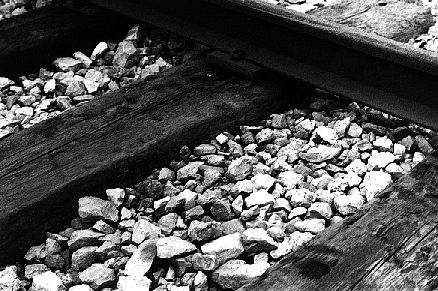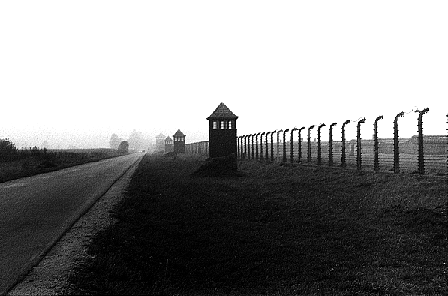
MY TRIP TO AUSCHWITZ
Auschwitz was the second station of my trip. A few days before leaving Boston, I remembered three mosaic stones that I had found in a heap in the City of David in Jerusalem many years ago. I fished them out of the bottom of a box. I decided to place one on the grave of the last Kronenberg buried in Geseke, the second in Birkenau, where my grandparents were murdered, and the third on my mother's gravestone in Berlin.
The stones gave me courage. I didn't realize it at the time, but the ritual allowed me to "pass through" these difficult "stations" protected. All I needed to do was show up. But then, it just seemed like the right thing to do.
Sitting in my compartment when I got on in Berlin was a German who said he was spending the weekend in Kracow. He had never been there before and wanted to see the architecture. I said I was changing at Katowice. We exchanged a few cursory remarks, but he never asked where I was from or where I was going. When the young Polish official checked my passport at the border, I joked, "Sieht mir doch ähnlich, nicht?" He laughed and said that it was unmistakeable. I remembered how serious border crossings used to be in Eastern Europe - no joking matter. The fellow across from me saw that my passport was American and was taken aback. I settled into my seat and looked at the flat landscape with its familiar villages. Fields broken by forests, then more fields, then small farmyards again. A barn with other buildings around a courtyard, a rich manure heap as its jewel. Occasionally, I saw farmers driving through the fields in horsedrawn wooden wagons and even a farmer plowing with a horse.
On the rail sidings in some of the towns were old wooden boxcars with curved roofs and sliding doors in the center, just like I remember. They looked so tiny. I had a set of Märklin trains when I was a child; the real thing doesn't look much bigger. Somewhere along the route, we passed a coal locomotive set out on display. That must have been in eastern Germany, though.
As we got closer, I imagined my grandparents and aunt separating out from a vast mass of spirits, waiting patiently for my arrival. They had seen me in Geseke and were awaiting their stone.
Occasionally, especially after Katowice, ugly industrial areas sprang up. After Katowice, we entered a sort of hell. The sun was beginning to set red in the sky. Patches of mist and smoke spread across the ground; all over, children tended small fires on the lawns in back of the houses, giving off a stench like burning garbage. Industrial slag heaps merged with marshland. The area looked and felt unhealthy. Older houses were in ruins; newer ones bore all the marks of socialist construction: cracks, discoloration, incompletion. Some streets were unpaved. Smoke stacks pumped effluent into the air. I didn't dare take photographs because I felt I would be violating people's privacy, showing them up in some way. Peeping at their poverty. So, I didn't. It wasn't my story. I was ashamed to be riding first class. My stone was in my left shirt pocket. That was what I came for.
Coal was being burned; a woman hoed in her garden.
I got to Oswiecim at dusk without a Zloty in my pocket and walked about two kilometers toward Auschwitz, figuring that the Christian Hospice would be right there. I passed a Catholic school and asked a priest where the Hospice was. He was very nice and dispatched two of his pupils, Thomas and Anna, to show me the way. Anna spoke English well and said she wanted to be a journalist. In my mind she became my Aunt Miriam, the youngest of my mother's sisters, the one who died there.
Auschwitz has two parts: Auschwitz I and Auschwitz II, or Birkenau. There were also about 40 satellite camps and a work camp on the I.G. Farben grounds, Monowitz, where Primo Levi worked. But those camps are all gone. The camp complex is now called the Auschwitz Museum.
The two camps affected me very differently. Large portions of Auschwitz I have been reconstructed. One can see the brutal standing cells in which four prisoners had to stand all night long in a cell measuring 1 meter square. They had to enter via a door some 2 feet high. If they were too exhausted to work the next day, that was the end of them.
One can see the starvation cells in which prisoners were simply locked up without food and drink until they expired. Oubliettes did not go out with the French Revolution.
One can see the wall where executions took place as well as the room in which summary trials were held and the holding room where prisoners waited for execution. Some of them didn't make it to the wall; blood could still be seen splattered up to the ceiling.
One can walk into the gas chamber and view a reconstructed crematorium oven.
The camp is a barbed wire palace; the paths are straight and wide and planted with beautiful high trees. For a while I hooked up with an English tour group. A Polish woman gave the museum tour to a group that was hardly able to understand. Her uncle had been interned in Auschwitz, and he made her promise to tell the world. At one point I was admiring the poplars and asked whether they had been there during the Nazi period. Yes. I asked why the Nazis would plant trees. She turned to me and said from between tight lips, "Because Germans love nature."
Somehow, even with all the horror that I know took place there, my mind was still able to wrap itself around Auschwitz I. It is on a human scale, and the buildings, no matter what their purpose, are demonstrably buildings. The reconstruction also seems to have tamed the place; it is too clean, too neat.
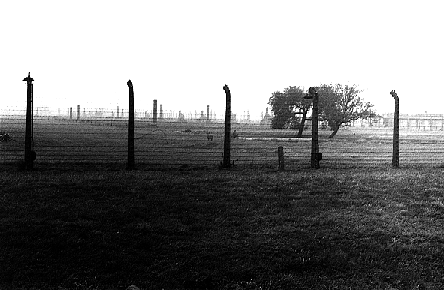
Birkenau is a different matter. For one thing, it is vast. What one sees is row upon row upon row upon row upon row upon row of naked chimneys. When the Nazis fled the onrushing Red Army, they burned the men's barracks and blew up the gas chambers and crematoria. In the mist of a cold, drizzly fall day, the effect is ghostly. But, I imagine that the effect would be equivalent on a clear spring day, a hot summer day, or a desolate winter day. I could not take my eyes off this tableau, nor could I penetrate it with my mind. By the act of destruction, which was the only thing the Nazis did really well, they created a holocaust memorial that no creative effort could possibly emulate and should not try.
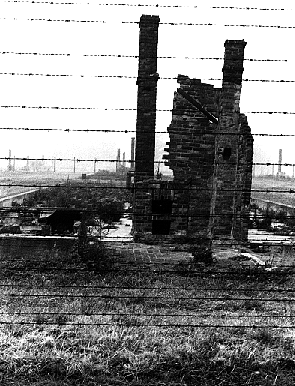
I felt very welcomed by the camp, very much at peace, as if I belonged there. I allowed myself to feel comfortable and protected. I had come to place a stone, and as I walked up the tracks leading to the selection platform, I decided that my stone should join the millions of stones that lay between the tracks. It is no small thing to place such a stone to honor the dead. If I had placed it in a barracks next to a chimney, it would have signified one thing; if I had tossed it into one of the destroyed gas chambers or crematoria, it would have meant something very different. The train tracks by the selection platform seemed like the right place, and my mind has given me to think that my three grandparents and Miriam* were well pleased.
As I continued walking up the tracks between the stone women's barracks on the left and the chimneys of the men's barracks, I noticed four small deer grazing among the chimneys. They looked at me intently, then walked a few paces parallel to the tracks, and then turned and looked at me again. I did not feel that I was chasing them; they seemed to be leading and waiting for me to catch up. I am generally a fairly sober person who looks for facts. But, I have arrived at a point where I will say that if you do not insist that they were spirits of the dead, I won't insist that they weren't. That is the effect that Birkenau can have.
I followed the deer, and when they turned a corner to the right, I found myself walking along a long, wide straight path with a gate at the far end. About half way down, several of the deer jumped the path and headed toward the back of the camp. I turned around and followed the tracks to the back as well, where, I found the crematoria. I walked through the wet grass toward the woods and then around crematoria IV and V. At one point, I became aware that the ground under my feet felt strange, dense and "thuddy," and I realized that I was walking on compacted ashes.
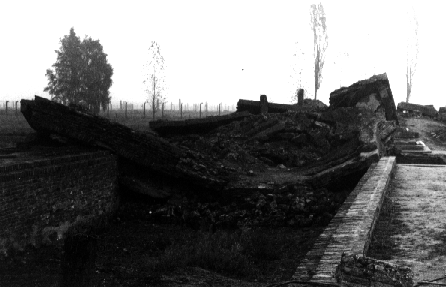
I stayed a total of about 6 hours in Auschwitz. I have been told by well-meaning people that I must have found it emotionally difficult to go there. Nothing could be further from the truth. I found it far more difficult to return home to the flatness of everyday life.
